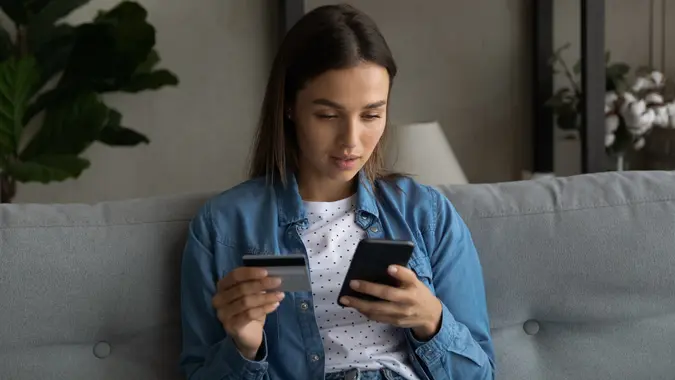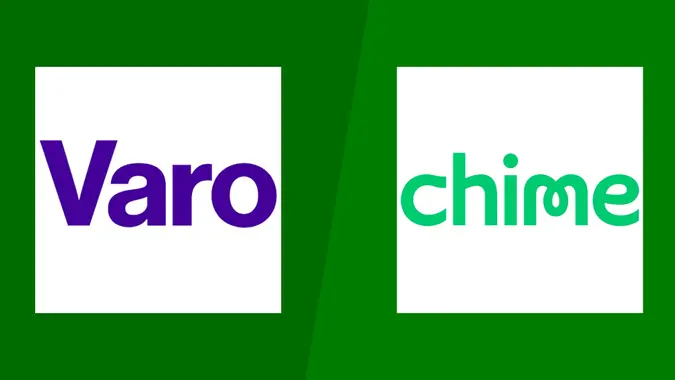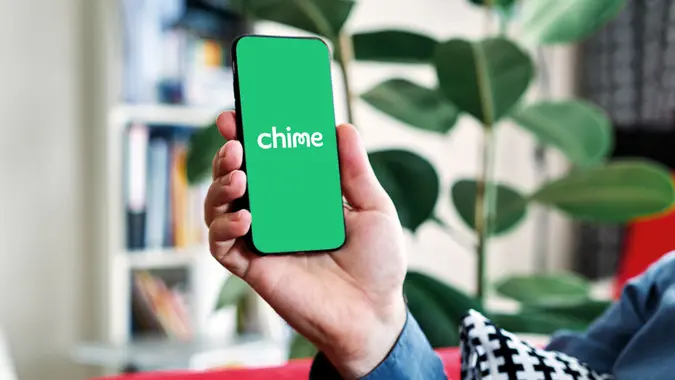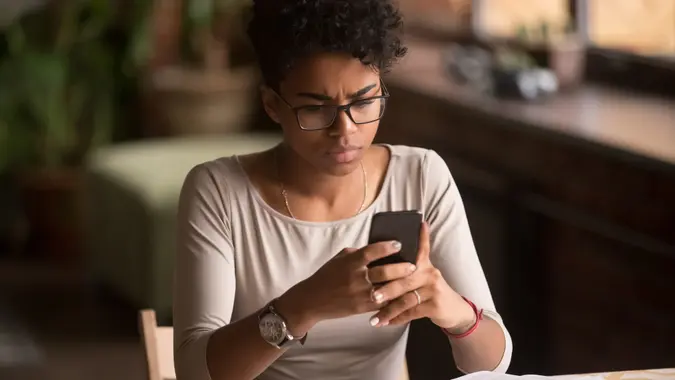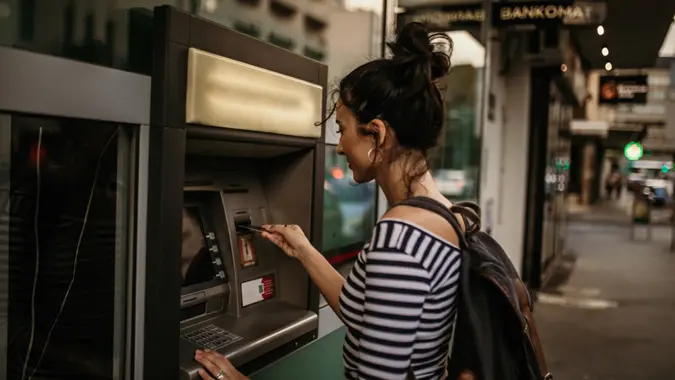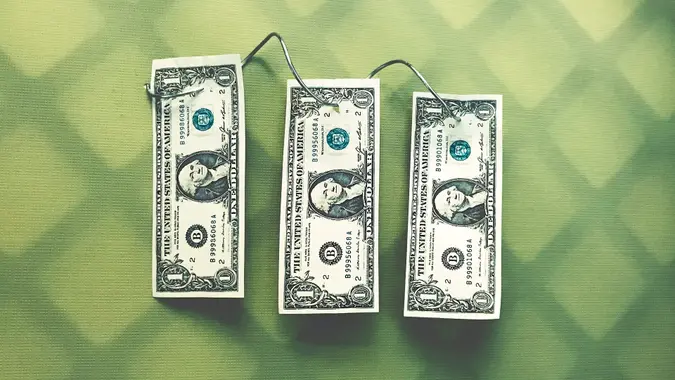What Is PayPal and How Does It Work?

Commitment to Our Readers
GOBankingRates' editorial team is committed to bringing you unbiased reviews and information. We use data-driven methodologies to evaluate financial products and services - our reviews and ratings are not influenced by advertisers. You can read more about our editorial guidelines and our products and services review methodology.

20 Years
Helping You Live Richer

Reviewed
by Experts

Trusted by
Millions of Readers
Founded in 1998, PayPal was one of the first widely adopted online peer-to-peer payment systems. Today, the platform has more than 426 million active account holders and remains a top secure option for money transfers and online shopping.
What Is PayPal, and How Does It Work?
PayPal is a popular digital payment network that allows people to send money to one another safely at no cost.
To use PayPal to send money to your family or friends, you’ll first need to start by creating a PayPal account. Then, link a bank account, debit card or credit card to your PayPal account. After that, you can securely send and receive money to and from your family and friends or make in-store or online purchases.
If you have a PayPal debit card or credit card, you can also make purchases in brick-and-mortar stores using your balance or line of credit. If you don’t have enough money in your account, you can set up PayPal to fund purchases using a debit card, credit card, checking account, or savings account of your choice.
In recent years, the online financial service has added features like the ability to buy and sell cryptocurrency; make purchases using bitcoin, bitcoin cash, Ethereum or Litecoin; open a PayPal line of credit; or use it to “buy now, pay later” at your favorite online stores that accept the online payment system.
What Is PayPal Credit?
PayPal Credit is a digital open-ended, or revolving, line of credit for online purchases. It can be used anywhere PayPal is used. If paid in full in six months on purchases of $99 or more, there is no interest, according to the site.
What Is PayPal in 4?
PayPal in 4 allows you to pay for your purchase in four equal installments. You must pay the first installment at the time of purchase. The following installments are due at 14-day intervals. No interest is charged.
Why Use PayPal?
PayPal is a convenient and secure method to pay for goods and services online. When you make an online payment, PayPal does not share your banking or credit card information with the merchants.
PayPal also has built-in protections — like data encryption and fraud monitoring — to provide extra security for its customers. And because PayPal stores your payment information itself, you can make multiple payments without needing to re-enter your credit card or banking information.
Is PayPal Free To Use?
For transactions in a single currency between family members and friends, PayPal does not charge a fee, but some transactions do come with a fee.
Fees for Currency Conversion
For transactions requiring a currency conversion, PayPal collects a fee of 3% above the base exchange rate from the recipient of the money.
Fees for International Transactions
For personal international transactions, the person sending the money also pays a 5% fee, with a minimum fee of $0.99 and a maximum of $4.99. These charges apply whether you use a PayPal balance, a bank account, a credit card, a debit card or an American Express® Send Account.
Fees for Purchases
When you pay for goods or services, the seller pays the associated fee, which is currently 2.99%. If a merchant sends an invoice or a consumer uses PayPal Checkout to make an online purchase, the seller pays 3.49% plus a fixed fee of $0.49 in the U.S. for domestic transactions.
Fees for Credit Card Payments
If you use your PayPal credit account or a credit card that is linked to your PayPal account for any transaction, business or personal, you’ll pay a fee of $0.30 plus 2.9% of the transaction.
How Do You Set Up a PayPal Account?
PayPal acts as a secure go-between to facilitate transactions between your bank and a third party, whether that’s an e-commerce merchant, a store, a service provider, a friend or a family member. Setting up your account is a simple process that can be done in just a few steps.
You can set up an account for free on PayPal’s website or by downloading the PayPal app from the App Store or Google Play. You will need to enter some basic personal information.
Once you have an account, you’ll want to link a bank account, credit card or debit card to the account. You can link one card to begin with, or you can link as many accounts as you’d like for more flexibility in managing your money.
How Do You Send Payments on PayPal?
Sending payments on PayPal is fairly straightforward. Make sure you follow the instructions below, but remember that the process may be a bit different depending on your recipient.
How Do You Send Payments to Friends and Family on PayPal?
If you’re sending money to a friend or family member, first enter their email address.
Then, enter the amount and the currency and click “friends and family” to send the money securely without fees. The recipient will get an email from PayPal indicating that they have received money. If they don’t have a PayPal account, they’ll need to set one up using the email address you sent the funds to.
How Do You Send Payments for Goods and Services on PayPal?
You can use PayPal to send payments for goods and services. To do so, simply enter the merchant’s email address and the amount of money you’re paying, then press “send.”
If you’re buying goods and services online, look for a PayPal QR code. If you see one, open the PayPal app, scan the QR code, and pay.
How Can You Accept Payments Through PayPal?
As PayPal is an online platform, there are a few ways to accept payments. Anyone with your email address can send you money as a PayPal user. Make sure they send it as a “family and friends” transaction so you won’t have to pay taxes on money sent as gifts, reimbursements or things like splitting the bill at dinner.
You can also set up a PayPal.me link so people can pay you easily with one click.
How do you get your money from PayPal?
With PayPal, when someone uses your email address or phone number to send funds, you’ll receive a notification that money is available. To accept the money, you must create an account if you don’t already have one. You can then keep the money in your PayPal account balance or transfer the funds to your bank account.
What are the disadvantages of using PayPal?
The disadvantages of using PayPal include accidentally receiving a payment marked as “paying for goods and services” and having to decline the transaction. Another is if you want to transfer money instantly from your account and into a bank account or linked debit card: This process will cost 1.75% or up to $25. There are also a few limitations on the amounts you can withdraw and transfer.
In addition, if you have a business account, you can’t access funds for 72 hours, and PayPal can freeze your account without much notice. If you have funds in your account at the time, the money will also be frozen.
Is there a fee to use PayPal?
Though most transactions between friends and family members are free, there could be a fee for instant transfers to a bank account, international transfers, linked credit card payments, or sending physical checks.
Does PayPal require a bank account?PayPal does not require a bank account to open an account. You only need to submit your full name, email address, phone number, and mailing address to do so. After you’ve opened an account, you can receive funds immediately, which you can keep in your PayPal account or add a debit or credit card or a bank account as a payment method.
Alternatives to PayPal
There are a few popular alternatives to PayPal. Here are some of the leading person-to-person payment platforms.
Venmo
Venmo lets you send and receive money. You can use it to buy goods and services from merchants or split a restaurant bill with friends, for example. Venmo is not recommended for sending or receiving payments for goods and services if you don’t know the other party.
Cash App
Cash App lets you send or receive money over your phone. You can use Cash App to pay for goods and services or to receive payments. You can also use Cash App to send Bitcoin or stocks.
Zelle
Zelle lets you send money directly from your bank account to another person’s bank account. You can use it even if the other person doesn’t use the same bank as you. Sending money via Zelle is a straightforward process: Just enter the other person’s email address or phone number and the amount you’re sending.
Final Take
PayPal is a fast, easy, secure and well-established way to make purchases and to send and receive money. If you don’t already have a PayPal account, it might be worth opening one. The payment method is becoming more widely accepted every day, and you can also find deals by shopping through PayPal at your favorite online retailers.
FAQ
Here are the answers to some of the most frequently asked questions regarding PayPal.- How does PayPal work and how do you get your money?
- With PayPal, when someone uses your email address or phone number to send funds, you’ll receive a notification that money is available. To accept the money, you must create an account if you don’t already have one. You can then keep the money in your PayPal account balance or transfer the funds to your bank account.
- What are the disadvantages of using PayPal?
- The disadvantages of using PayPal include accidentally receiving a payment marked as "paying for goods and services" and having to decline the transaction. Another is if you want to transfer money instantly from your account and into a bank account or linked debit card: This process will cost 1.75% or up to $25. There are also a few limitations on the amounts you can withdraw and transfer. In addition, if you have a business account, you can’t access funds for 72 hours, and PayPal can freeze your account without much notice. If you have funds in your account at the time, the money will also be frozen.
- Is there a fee to use PayPal?
- Though most transactions between friends and family members are free, there could be a fee for instant transfers to a bank account, international transfers, linked credit card payments or sending physical checks.
- Does PayPal require a bank account?
- PayPal does not require a bank account to open an account. You only need to submit your full name, email address, phone number, and mailing address to do so. After you’ve opened an account, you can receive funds immediately, which you can keep in your PayPal account or add a debit or credit card or a bank account as a payment method.
Dawn Allcot and Caitlyn Moorhead contributed to the reporting for this article.
Information is accurate as of Nov. 22, 2024.
Editorial Note: This content is not provided by any entity covered in this article. Any opinions, analyses, reviews, ratings or recommendations expressed in this article are those of the author alone and have not been reviewed, approved or otherwise endorsed by any entity named in this article.
 Written by
Written by  Edited by
Edited by 




